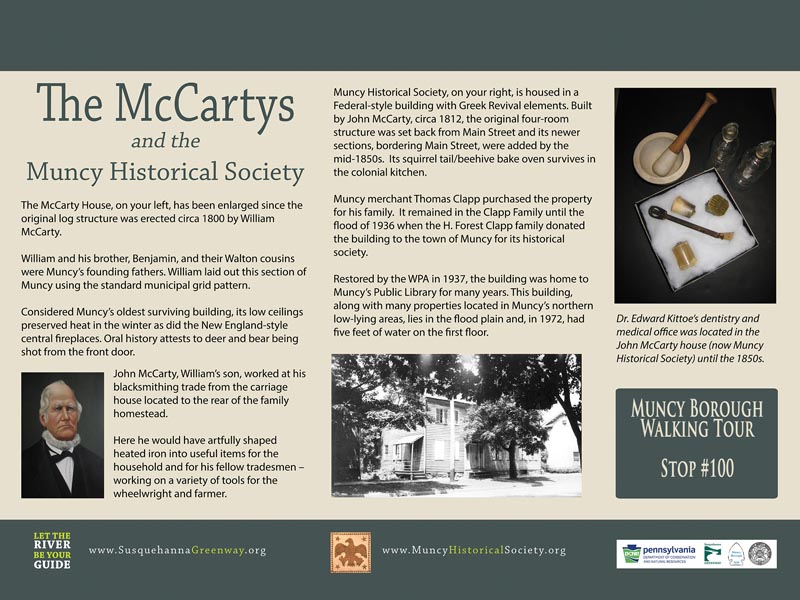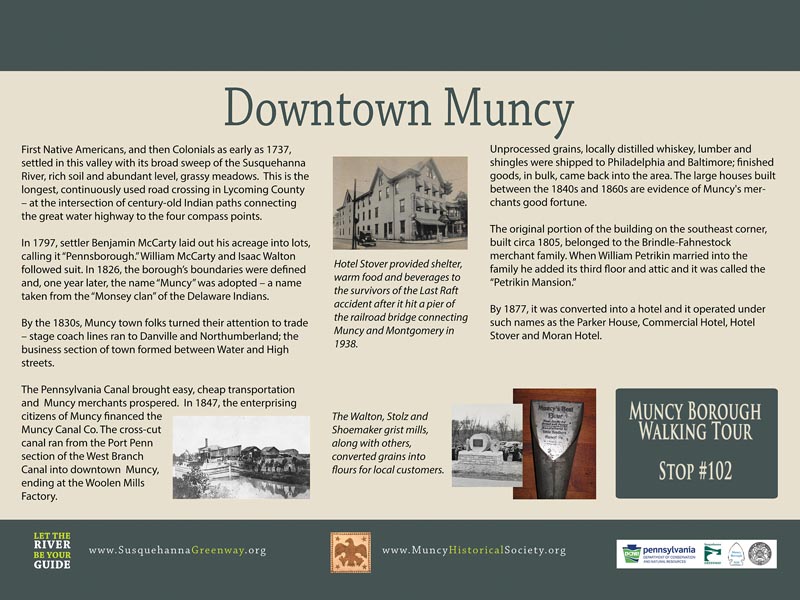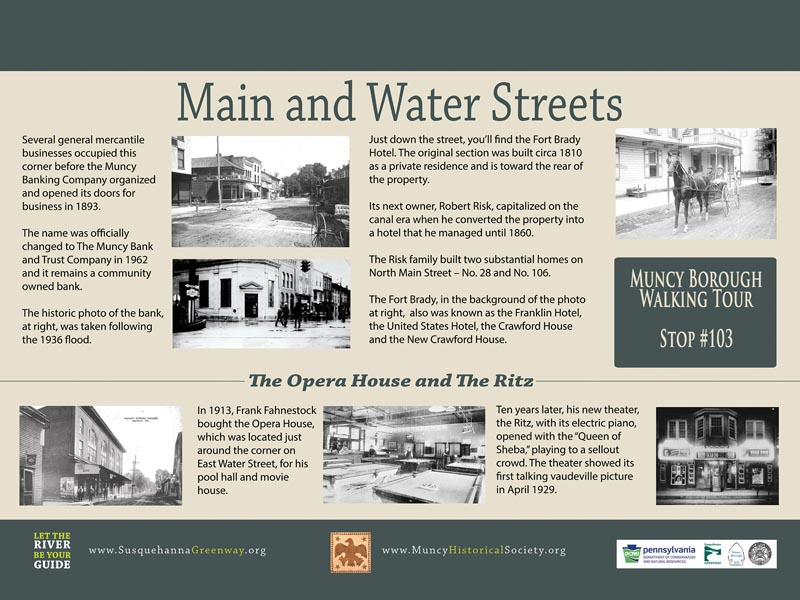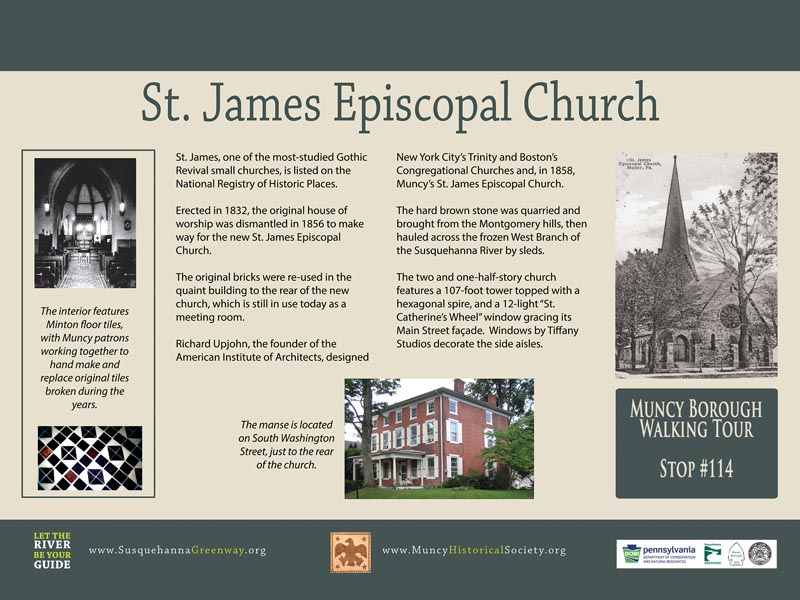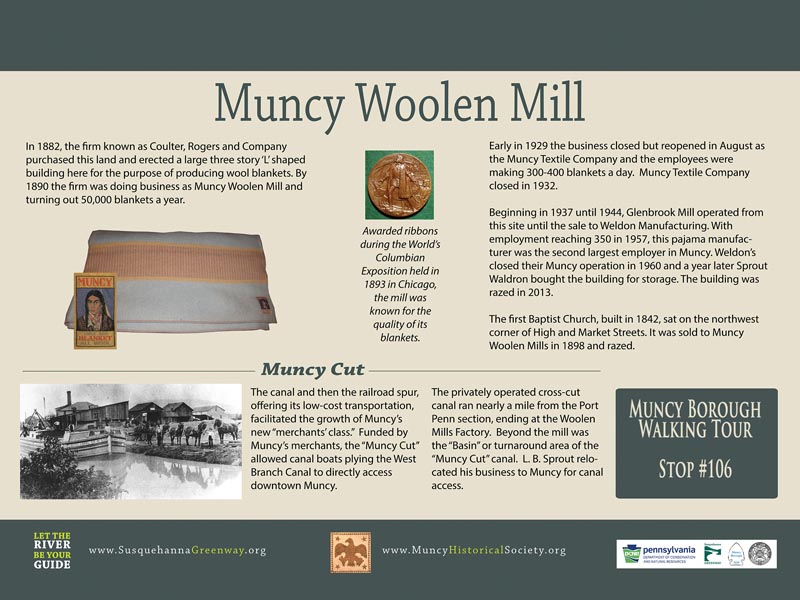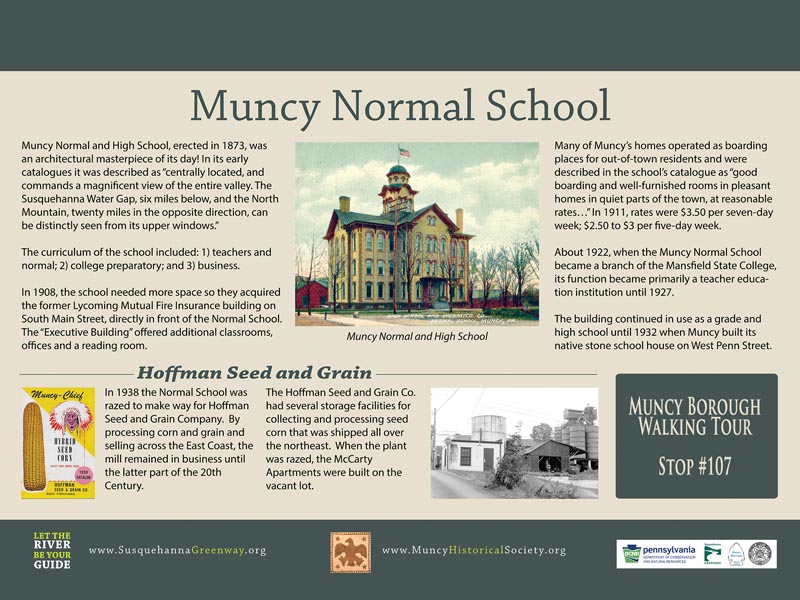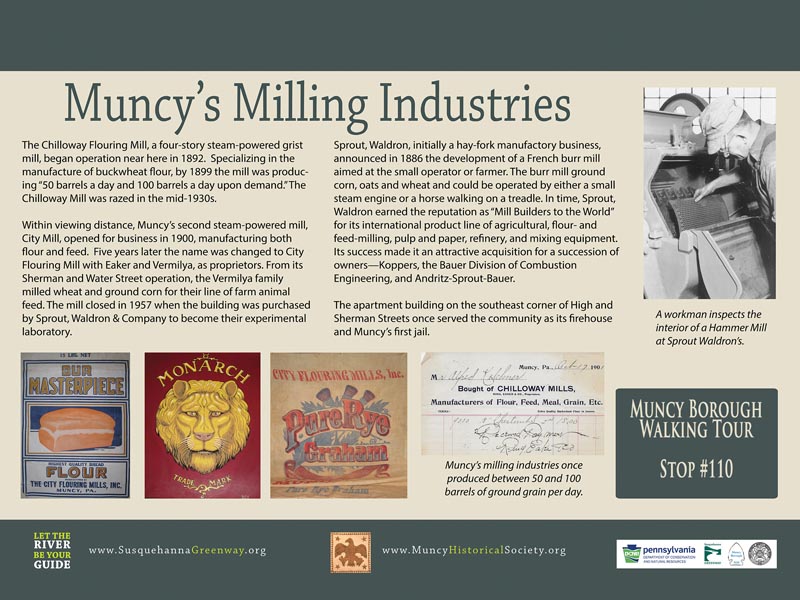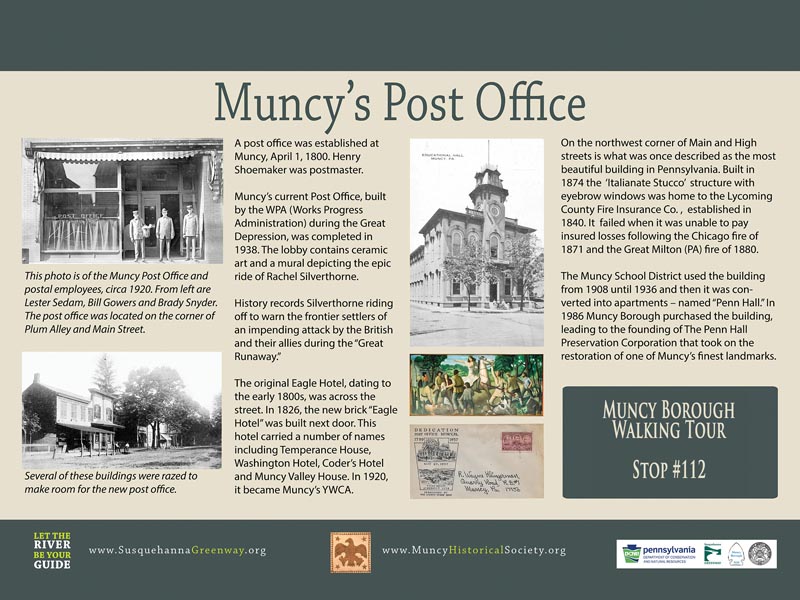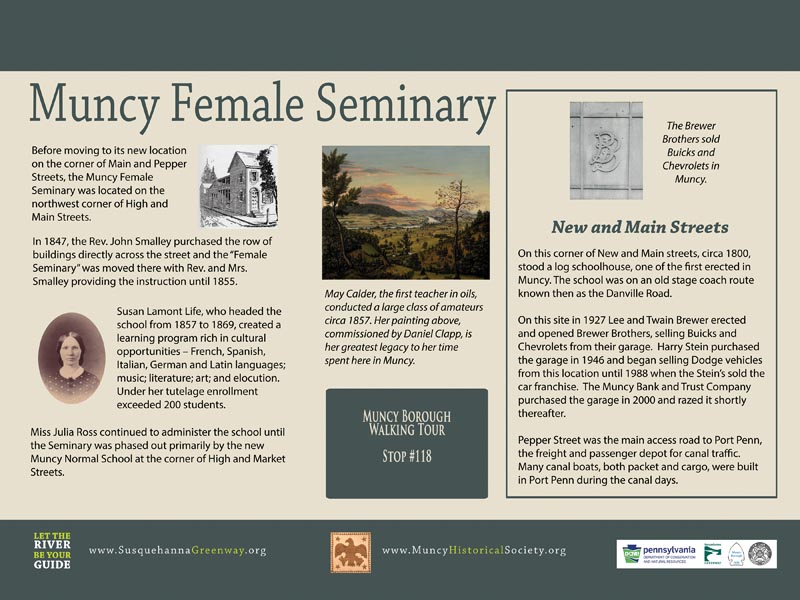Welcome to the Walking Tour of Historic Muncy, PA, brought to you by Muncy Historical Society, Muncy Borough, Susquehanna Greenways and the DCNR.
Muncy Historical Society and Museum of History, a not-for-profit, all-volunteer organization founded in 1936, focuses on preservation and conservation of the rich history and heritage of Muncy and surrounding communities – its people, businesses, education, arts, traditions, and folklore – by sponsoring educational programs and activities, through research and publication of our history, and interpretation of the museum’s collection for the community, including schools, colleges, community groups, and professional historians.
Muncy Borough, in Northcentral Pennsylvania, is one of the earliest settlements in the West Branch Valley. Muncy and its residents were participants in some of the most significant historic events in the making of the American Frontier, including the French and Indian War and the Revolutionary War.
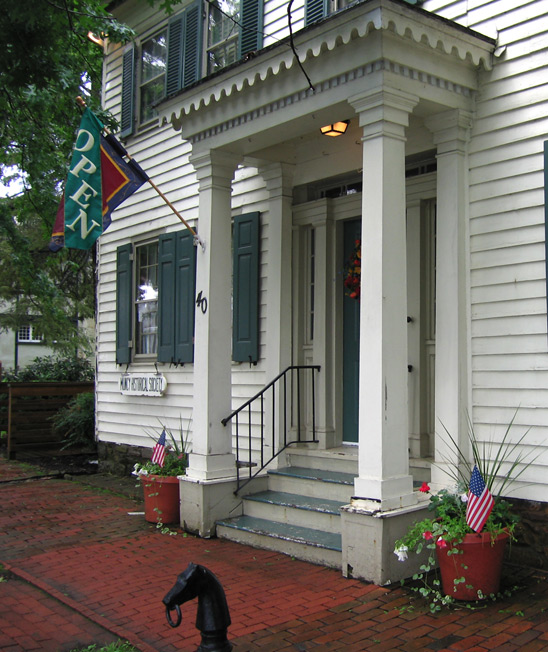
Explorers recognized its importance because of its proximity to the Susquehanna River, and the numerous Indian trails that crisscrossed the landscape. Pioneers cleared land, planted crops, and built cabins as early as 1752, hoping to farm and trade with the Munsee Indians who lived nearby.
In 1797, brothers Benjamin and William McCarty laid out the town of Pennsborough. Derisively nicknamed “Hardscrable,” the small village grew slowly. Pennsborough was incorporated as a borough on March 15, 1826, then, on January 19, 1827, the name of Pennsborough was changed to Muncy.
In the 1830s, John P. Schuyler and Joshua Alder purchased 50 acres that became known as Port Penn. The neighborhood would, first, be dissected by the West Branch Canal and, later, the Philadelphia and Reading Railroad – both important to Muncy’s growth. Manufacturing flourished and the small community on the southwest side of the Borough supported a variety of trades, products, and businesses.
Historically, Muncy was an ideal community for commerce and industry. Located on the West Branch of the Susquehanna River, Muncy developed a thriving lumber industry complete with saw and planing mills. Timber raftsmen moving logs down the Susquehanna to the Chesapeake often stopped at Muncy. They frequented the taverns and hotels and certainly kept area distilleries in business. At the time period, there were thirteen distilleries in the area with an output of up to 1,500 gallons per day.
The West Branch Canal became a great business thoroughfare and its chief exports locally were hogs, wheat, flour, lumber, leather, and whiskey.
The canal ended in town at the Muncy Woolen Mills. Nearby, Muncy’s Main Street began to fill with shops and industry. There were carriage makers, an iron foundry, broom makers, dry goods stores, drug stores, a newspaper office, hotels, restaurants and even an opera house that also held the town’s billiard room. A hospital was established.
Something for Everyone
Muncy Historical Society not only has permanent exhibits in its historic museum, but it also maintains the Walton Graveyard and the Hill Burial Ground, the circa 1860s PA packet boat, Muncy’s Civil War Soldiers’ Monument, the Muncy Heritage Quilt Trail, the Muncy Heritage Park & Nature Trail, and the Brady Heritage Park.
Muncy Borough
Walking Tour
The Borough
(Click a link to go directly to a Tour Stop)
Stop 101: The McCartys
Stop 102: Downtown Muncy
Stop 103: Main and Water Streets
Stop 104: St. James Episcopal Church
Stop 106: Muncy Woolen Mill
Stop 107: Muncy Normal School
Stop 110: Muncy’s Milling Industries
Stop 112: Muncy Post Office
Stop 118: Muncy Female Seminary
Heritage Park & Nature Trail
Use the Google Map below to virtually explore Muncy’s Heritage Park & Nature Trail. Send directions to your device and visit the park, exploring 11 beautiful acres. The park features interpretive panels that introduce the visitor to the wildlife of the area, as well as its historical past as an important double-lock on the Muncy Canal.
Muncy Borough Walking Tour
Stop 100: The McCartys
The McCarty House, on your left, has been enlarged since the original log structure was erected circa 1800 by William McCarty. William and his brother, Benjamin, and their Walton cousins were Muncy’s founding fathers. William laid out this section of Muncy using the standard municipal grid pattern. Considered Muncy’s oldest surviving building, its low ceilings preserved heat in the winter as did the New England-style central fireplaces. Oral history attests to deer and bear being shot from the front door.
John McCarty, William’s son, worked at his blacksmithing trade from the carriage house located to the rear of the family homestead. Here he would have artfully shaped heated iron into useful items for the household and for his fellow tradesmen – working on a variety of tools for the wheelwright and farmer.
Muncy Historical Society, on your right, is housed in a Federal-style building with Greek Revival elements. Built by John McCarty, circa 1812, the original four-room structure was set back from Main Street and its newer sections, bordering Main Street, were added by the mid-1850s. Its squirrel tail/beehive bake oven survives in the colonial kitchen.
Dr. Edward Kittoe’s dentistry and medical office was located here until the 1850s when Muncy merchant Thomas Clapp purchased the property for his family. It remained in the Clapp Family until the flood of 1936 when the H. Forest Clapp family donated the building to the town of Muncy for its historical society.
Restored by the WPA in 1937, the building was home to Muncy’s Public Library for many years. This building, along with many properties located in Muncy’s northern low-lying areas, lies in the flood plain and, in 1972, had five feet of water on the first floor.
Stop 102: Downtown Muncy
First Native Americans, and then Colonials as early as 1737, settled in this valley with its broad sweep of the Susquehanna River, rich soil and abundant level, grassy meadows. This is the longest, continuously used road crossing in Lycoming County – at the intersection of four, century-old paths connecting the great water highway to the north, east and west.
In 1797, settler Benjamin McCarty laid out his acreage into lots, calling it “Pennsborough.” William McCarty and Isaac Walton followed suit. In 1826, the borough’s boundaries were defined and, one year later, the name “Muncy” was adopted – a name taken from the “Monsey clan” of the Delaware Indians.
By the 1830s, Muncy town folks turned their attention to trade – stage coach lines ran to Danville and Northumberland; the business section of town formed between Water and High streets. The Pennsylvania Canal brought easy and cheap transportation and with the canal, and later the railroad, Muncy merchants prospered. Unprocessed grains, locally distilled whiskey, lumber and shingles were shipped to Philadelphia and Baltimore; finished goods, in bulk, came back into the area. The big houses built between the 1840s and 1860s are evidence of their good fortune.
The original portion of the building on the southeast corner, built circa 1805, belonged to the Brindle-Fahnestock merchant family. When William Petrikin married into the family he added its third floor and attic and it was called the “Petrikin Mansion.” By 1877, it was converted into a hotel and it operated under such names as the Parker House, Commercial Hotel, Hotel Stover and Moran Hotel.
Stop 103: Main and Water Streets
Several general mercantile businesses occupied this corner before the Muncy Banking Company organized and opened its doors for business in 1893. The name was officially changed to The Muncy Bank and Trust Company in 1962 and it remains a community-owned bank.
Just down the street, you’ll find the Fort Brady Hotel. The original section was built circa 1810 as a private residence and is toward the rear of the property. Its next owner, Robert Risk, capitalized on the canal era when he converted the property into a hotel that he managed until 1860. The Risk family built two substantial homes on North Main Street – No. 28 and No. 106. The Fort Brady also was known as the Franklin Hotel, the United States Hotel, the Crawford House and the New Crawford House.
Stop 104: St. James Episcopal Church
Erected in 1832, the original house of worship was dismantled in 1856 to make way for the new St. James Episcopal Church. The original bricks were re-used in the quaint building to the rear of the new church, which is still in use today as a meeting room.
Richard Upjohn, the founder of the American Institute of Architects, designed New York City’s Trinity and Boston’s Congregational Churches and, in 1858, Muncy’s St. James Episcopal Church. St. James, one of the most-studied Gothic Revival small churches, is listed on the National Registry of Historic Places.
The hard brown stone was quarried and brought from the Montgomery hills, then hauled across the frozen West Branch of the Susquehanna River by sleds. The two and one-half-story church features a 107-foot tower topped with a hexagonal spire, and a 12-light “St. Catherine’s Wheel” window gracing its Main Street façade. Windows by Tiffany Studios decorate the side aisles. The interior features Minton floor tiles, with Muncy patrons working together to hand make and replace original tiles broken during the years.
The manse is located on South Washington Street, just to the rear of the church.
Stop 106: Muncy Woolen Mill
In 1882 the firm known as Coulter, Rogers and Company purchased this land and erected a large three story ‘L’ shaped building here for the purpose of producing wool blankets. By 1890 the firm was doing business as Muncy Woolen Mill and turning out 50,000 blankets a year. Awarded ribbons during the World’s Columbian Exposition held in 1893 in Chicago, the mill was known for the quality of its blankets.
Early in 1929 the business closed but reopened in August as the Muncy Textile Company and the employees were making 300-400 blankets a day. Muncy Textile Company closed in 1932. Beginning in 1937 until 1944, Glenbrook Mill operated from this site until the sale to Weldon Manufacturing. With employment reaching 350 in 1957, this pajama manufacturer was the second largest employer in Muncy. Weldon’s closed their Muncy operation in 1960 and a year later Sprout Waldron bought the building for storage. The building was razed in 2013.
The first Baptist Church, built in 1842, sat on the northwest corner of High and Market Streets. It was sold to Muncy Woolen Mills in 1898 and razed.
The canal and then the railroad spur, offering its low-cost transportation, facilitated the growth of Muncy’s new “merchants’ class.” Funded by Muncy’s merchants, the “Muncy Cut” allowed canal boats plying the West Branch Canal to directly access downtown Muncy.
The privately operated cross-cut canal ran nearly a mile from the Port Penn section, ending at the Woolen Mills Factory. Beyond the mill was the “Basin” or turnaround area of the “Muncy Cut” canal. Formerly a Picture Rocks company, L.B. Sprout relocated to Muncy for canal access.
Stop 107: Muncy Normal School
The Muncy Normal and High School building, erected in 1873, was an architectural masterpiece of its day! In its early catalogues it was described as “centrally located, and commands a magnificent view of the entire valley. The Susquehanna Water Gap, six miles below, and the North Mountain, twenty miles in the opposite direction, can be distinctly seen from its upper windows.”
The curriculum of the school included: 1) teachers and normal; 2) college preparatory; and 3) business. About 1922, when the Muncy Normal School became a branch of the Mansfield State College, its function became primarily a teacher education institution until 1927.
In 1908, the school needed more space so they acquired the former Lycoming Mutual Fire Insurance building on South Main Street, directly in front of the Normal School. The “Executive Building” offered additional classrooms, offices and a reading room.
Many of Muncy’s homes operated as boarding places for out-of-town residents and were described in the school’s catalogue as “good boarding and well-furnished rooms in pleasant homes in quiet parts of the town, at reasonable rates…” In 1911, rates were $3.50 per seven-day week; $2.50 to $3 per five-day week.
The building continued in use as a grade and high school until 1932 when Muncy built its native stone school house on West Penn Street. In 1938 the Normal School was razed to make way for Hoffman Seed and Grain Company. Processing corn and grain and selling across the East Coast the mill remained in business until the latter part of the 20th Century when the plant was razed and the McCarty Apartments were built on the vacant lot.
Stop 110: Muncy’s Milling Industries
The Chilloway Flouring Mill, a four-story steam-powered grist mill, began operation near here in 1892. Specializing in the manufacture of buckwheat flour, by 1899 the mill was producing “50 barrels a day and 100 barrels a day upon demand.” The Chilloway Mill was razed in the mid-1930s.
Within viewing distance, Muncy’s second steam-powered mill, City Mill, opened for business in 1900, manufacturing both flour and feed. Five years later the name was changed to City Flouring Mill with Eaker and Vermilya, as proprietors. From its Sherman and Water Street operation, the Vermilya family milled wheat and ground corn for their line of farm animal feed. The mill closed in 1957 when the building was purchased by Sprout, Waldron & Company to become their experimental laboratory.
Sprout, Waldron, initially a hay-fork manufactory business, announced in 1886 the development of a French burr mill aimed at the small operator or farmer. The burr mill ground corn, oats and wheat and could be operated by either a small steam engine or a horse walking on a treadle. In time, Sprout, Waldron earned the reputation as “Mill Builders to the World” for its international product line of agricultural, flour- and feed-milling, pulp and paper, refinery, and mixing equipment. Its success made it an attractive acquisition for a succession of owners—Koppers, the Bauer Division of Combustion Engineering, and Andritz-Sprout-Bauer.
Stop 112: Muncy Post Office
Muncy’s Post Office, built by the WPA (Works Progress Administration) during the Great Depression, was completed in 1938. The lobby contains ceramic art and a mural depicting the epic ride of Rachel Silverthorne. History records Silverthorne riding off to warn the frontier settlers of an impending attack by the British and their allies during the “Great Runaway.”
Diagonally across the street is what was once described as the most beautiful building in Pennsylvania. Built in 1874 the ‘Italianate Stucco’ structure with eyebrow windows was home to the Lycoming County Fire Insurance Company. The firm was established in 1840 as Lycoming County Mutual Fire Insurance Company and in 1870 amended its charter to reflect its business expansion into other counties and states. The company failed when it was unable to pay its insured losses following the Chicago fire of 1871 and the Great Milton (PA) fire of 1880.
The Muncy School District used the building from 1908 until 1936 and then it was converted into apartments – named “Penn Hall.” In 1986 Muncy Borough purchased the building, leading to the founding of The Penn Hall Preservation Corporation that took on the restoration of one of Muncy’s finest landmarks.
Across the street was once the original Sign of the Eagle or Eagle Hotel and private residence dating to the early 1800s. In 1826 the new brick “Eagle Hotel” was built next door. This hotel carried a number of names including Temperance House, Washington Hotel, Coder’s Hotel and Muncy Valley House. In 1920 it became Muncy’s YWCA and later an apartment building.
Stop 118: Muncy Female Seminary
On this corner of New and Main streets, c. 1800, stood a log schoolhouse, one of the first erected in Muncy. The school was on an old stage coach route known then as the Danville Road. On this site in 1927 Lee and Twain Brewer erected and opened Brewer Brothers, selling Buicks and Chevrolets from their garage. Harry Stein purchased the garage in 1946 and began selling Dodge vehicles from this location until 1988 when the Stein’s sold the car franchise. The Muncy Bank and Trust Company purchased the garage in 2000 and razed it shortly thereafter.
Before moving to its new location on Pepper Street, the Muncy Female Seminary was located on the northwest corner of High and Main Streets. In 1847 Rev. John Smalley purchased the row of buildings directly across the street and the “Female Seminary” was moved there with Rev. and Mrs. Smalley providing the instruction until 1855.
Susan Lamont Life, who headed the school from 1857 to 1869, created a learning program rich in cultural opportunities – French, Spanish, Italian, German and Latin languages; music; literature; art; and elocution. Under her tutelage enrollment exceeded 200 students. Miss Julia Ross continued to administer the school until the Seminary was phased out primarily by the new Muncy Normal School at the corner of High and Market Streets.
Pepper Street was the main access road to Port Penn, the freight and passenger depot for canal traffic. A great many canal boats, both packet and cargo, were built in Port Penn during the canal days.

